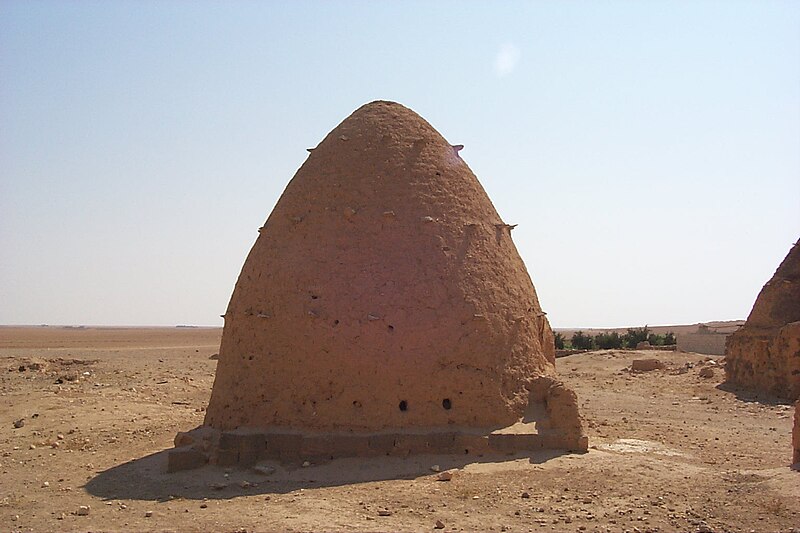File:Traditional adobe beehive architecture of Syria.jpg

Original file (1,536 × 1,024 pixels, file size: 283 KB, MIME type: image/jpeg)
Captions
Captions
Summary[edit]
| DescriptionTraditional adobe beehive architecture of Syria.jpg |
Way before there were electronic ways to condition our temperatures, cooling methods were built into the architecture of traditional Middle Eastern homes, such as the beehive homes found in Syria. Remaining beehive homes (nicknamed “beehive” because of their conical, tapered shapes) are located mainly in northern Syria – west and east of the Aleppo and along the Euphrates River. Two towns that still have a number of these traditional beehive homes in good shape are Sarouj and Twalid Dabaghein. The beehive homes keep the heat out in a few ways. Their thick mud brick walls trap in the cool and keep the sun out as well (beehive homes have very few, if any, windows). The high domes of the beehive houses also collect the hot air, moving it away from the residents sleeping at the bottom of the house.Combining natural elegance with architectural functionality, the shapes of the beehive homes keep interior temperatures between 75-85 degrees Fahrenheit. The beehive homes also protect their residents from cold temperatures, serving as a strong guard against powerful desert winds and maintaining a comfortable temperature. Designed for the desert climate, the beehive homes keep the heat out in a few ways. Their thick mud brick walls trap in the cool and keep the sun out as well (beehive homes have very few, if any, windows). The high domes of the beehive houses also collect the hot air, moving it away from the residents sleeping at the bottom of the house. Inside, its high dome serves to collect the hotter air, and outside to shed rainfall instantly, before the brick can absorb it and crumble. Its thick roof-cum-wall is an excellent low-velocity heat-exchanger, and keeps interior temperatures between 85° and 75° F. while outside noon-to-midnight extremes range from 140° to 60°. |
| Date | |
| Source | Traditional adobe beehive architecture of Syria |
| Author | James Gordon from Los Angeles, California, USA |
Licensing[edit]
- You are free:
- to share – to copy, distribute and transmit the work
- to remix – to adapt the work
- Under the following conditions:
- attribution – You must give appropriate credit, provide a link to the license, and indicate if changes were made. You may do so in any reasonable manner, but not in any way that suggests the licensor endorses you or your use.
| This image was originally posted to Flickr by james_gordon_losangeles at https://www.flickr.com/photos/79139277@N08/7430372150. It was reviewed on 29 October 2012 by FlickreviewR and was confirmed to be licensed under the terms of the cc-by-2.0. |
29 October 2012
File history
Click on a date/time to view the file as it appeared at that time.
| Date/Time | Thumbnail | Dimensions | User | Comment | |
|---|---|---|---|---|---|
| current | 12:01, 29 October 2012 |  | 1,536 × 1,024 (283 KB) | Stobkcuf (talk | contribs) | == {{int:filedesc}} == {{Information |Description=Way before there were electronic ways to condition our temperatures, cooling methods were built into the architecture of traditional Middle Eastern homes, such as the beehive homes found in Syria. Remai... |
You cannot overwrite this file.
File usage on Commons
There are no pages that use this file.
File usage on other wikis
The following other wikis use this file:
- Usage on en.wikipedia.org
- Usage on es.wikipedia.org
Metadata
This file contains additional information such as Exif metadata which may have been added by the digital camera, scanner, or software program used to create or digitize it. If the file has been modified from its original state, some details such as the timestamp may not fully reflect those of the original file. The timestamp is only as accurate as the clock in the camera, and it may be completely wrong.
| Camera manufacturer | Eastman Kodak Company |
|---|---|
| Camera model | KODAK DIGITAL SCIENCE DC260 (V01.00) |
| Exposure time | 63/20,000 sec (0.00315) |
| F-number | f/10.15 |
| Date and time of data generation | 11:37, 4 January 1998 |
| Lens focal length | 8.96 mm |
| Orientation | Normal |
| Horizontal resolution | 72 dpi |
| Vertical resolution | 72 dpi |
| Y and C positioning | Centered |
| Exif version | 2 |
| Meaning of each component |
|
| Image compression mode | 2.4 |
| APEX shutter speed | 9 |
| APEX aperture | 7 |
| APEX exposure bias | 0 |
| Maximum land aperture | 3 APEX (f/2.83) |
| Metering mode | Center weighted average |
| Light source | Unknown |
| Supported Flashpix version | 1 |
| Color space | sRGB |